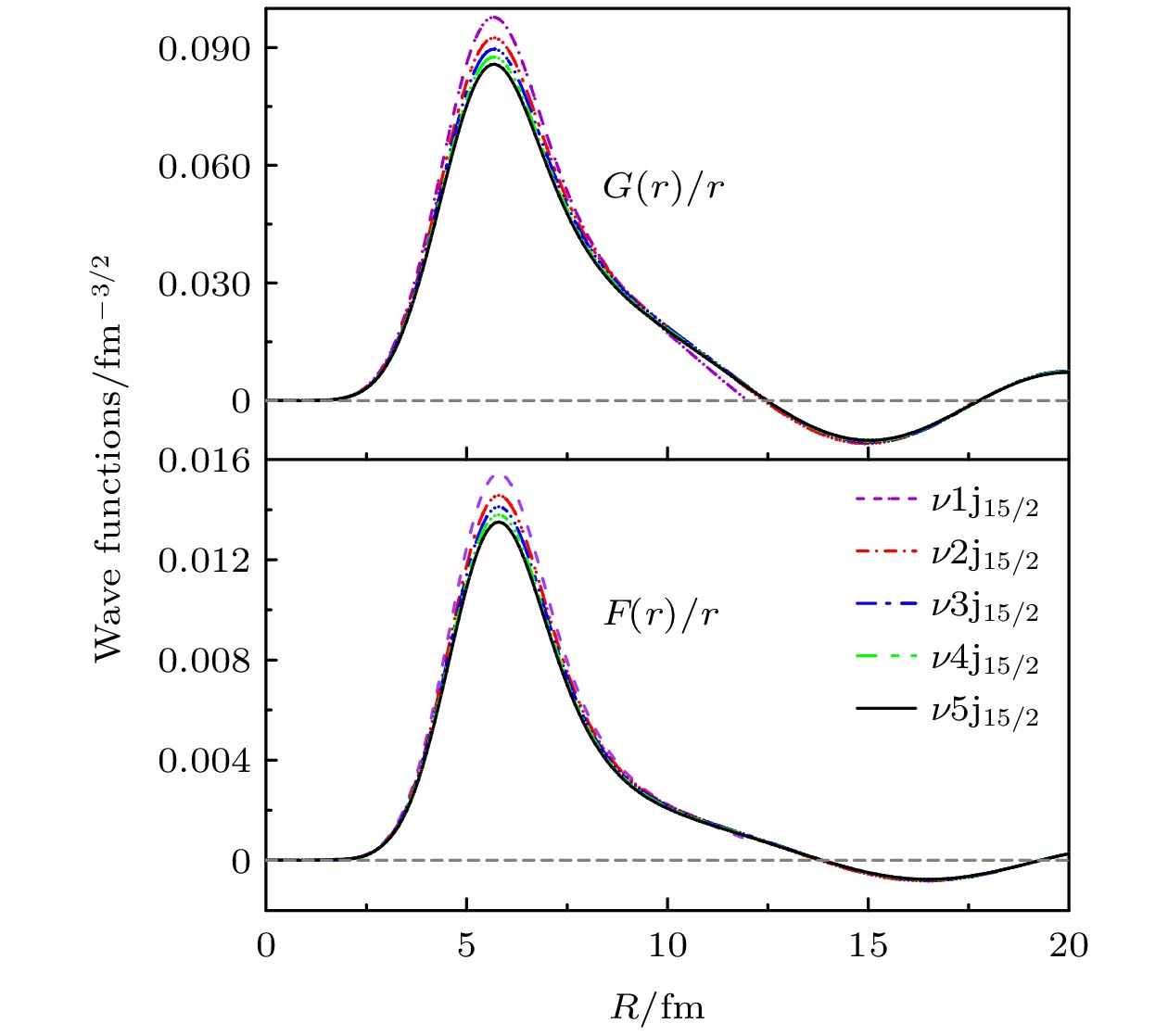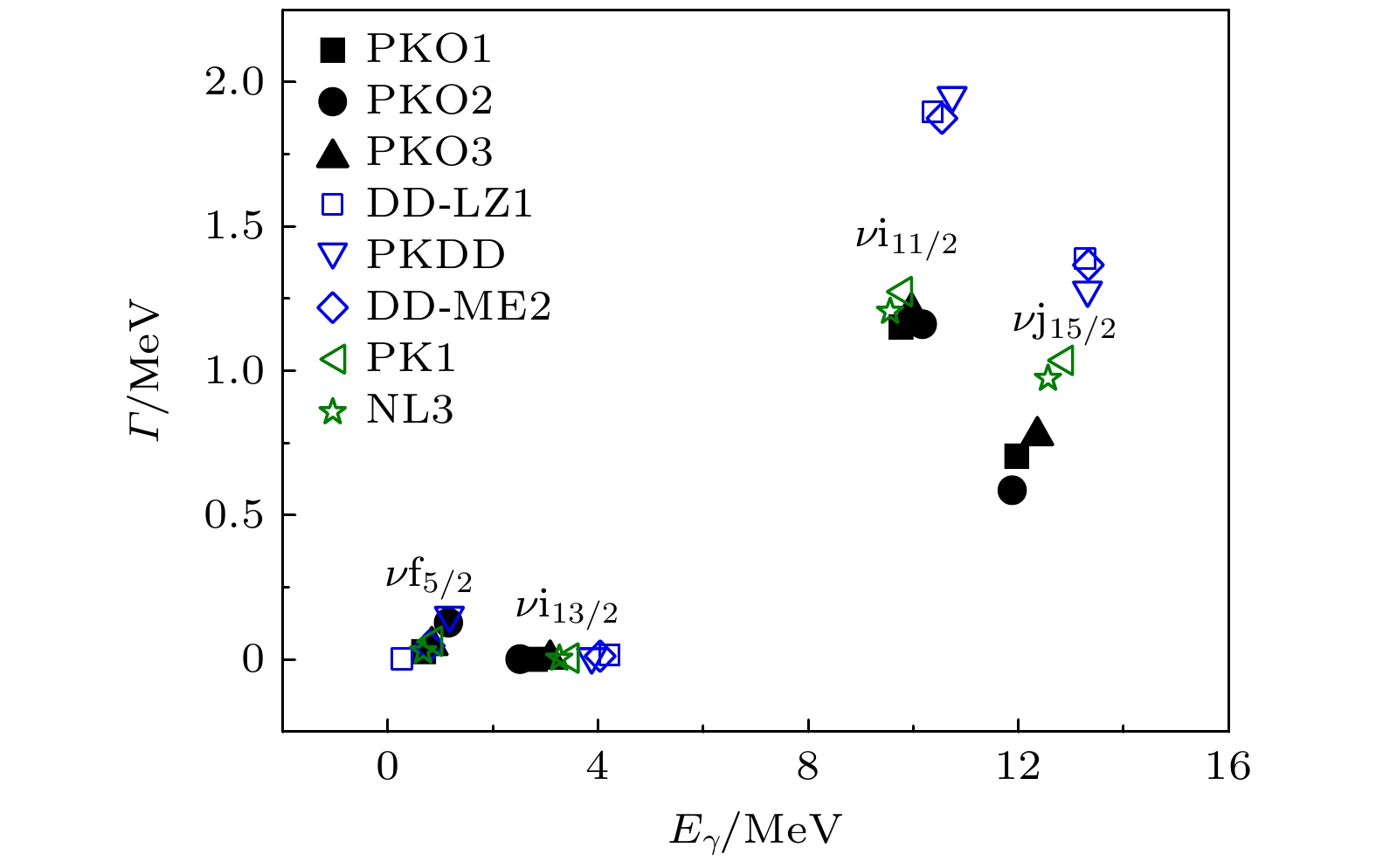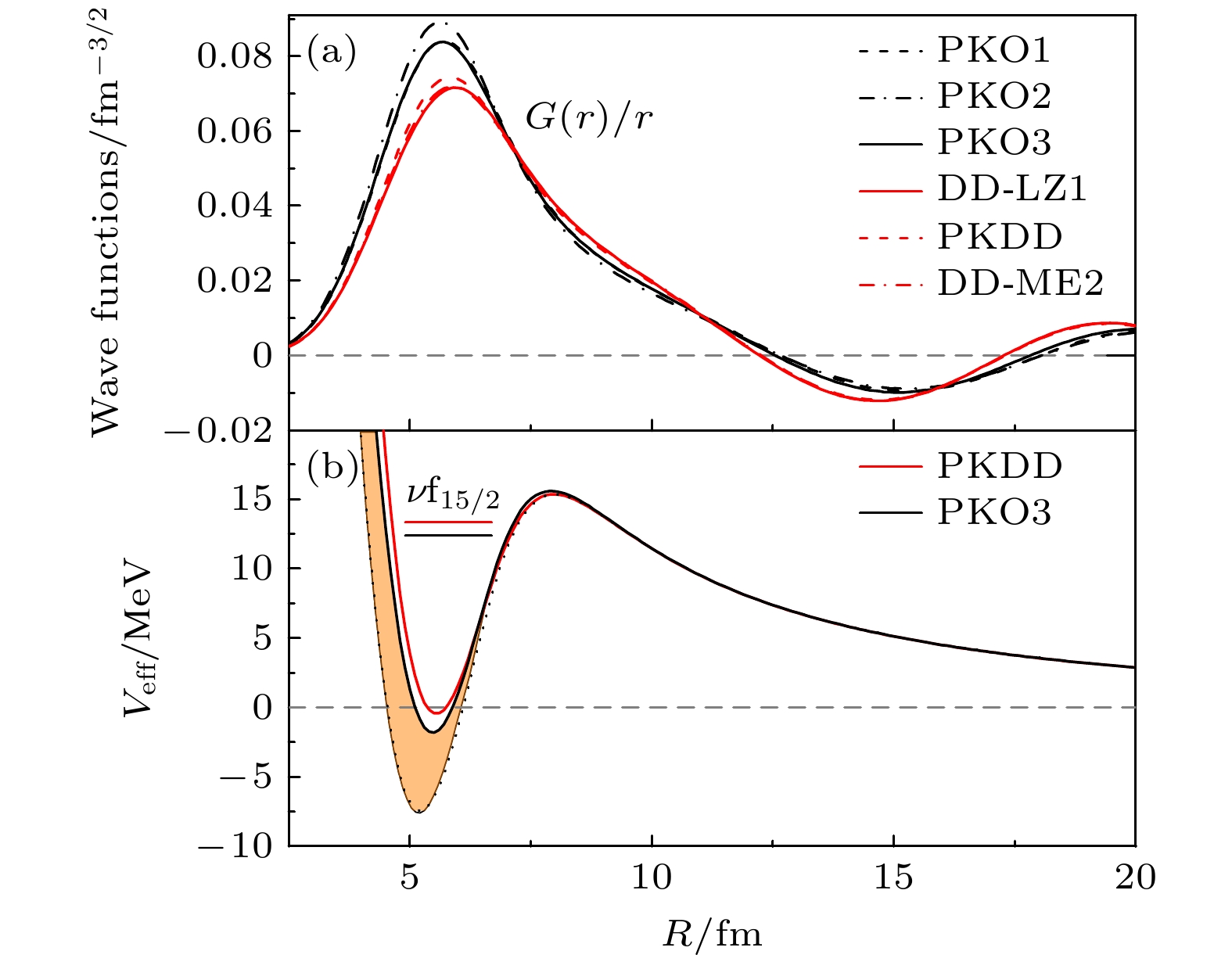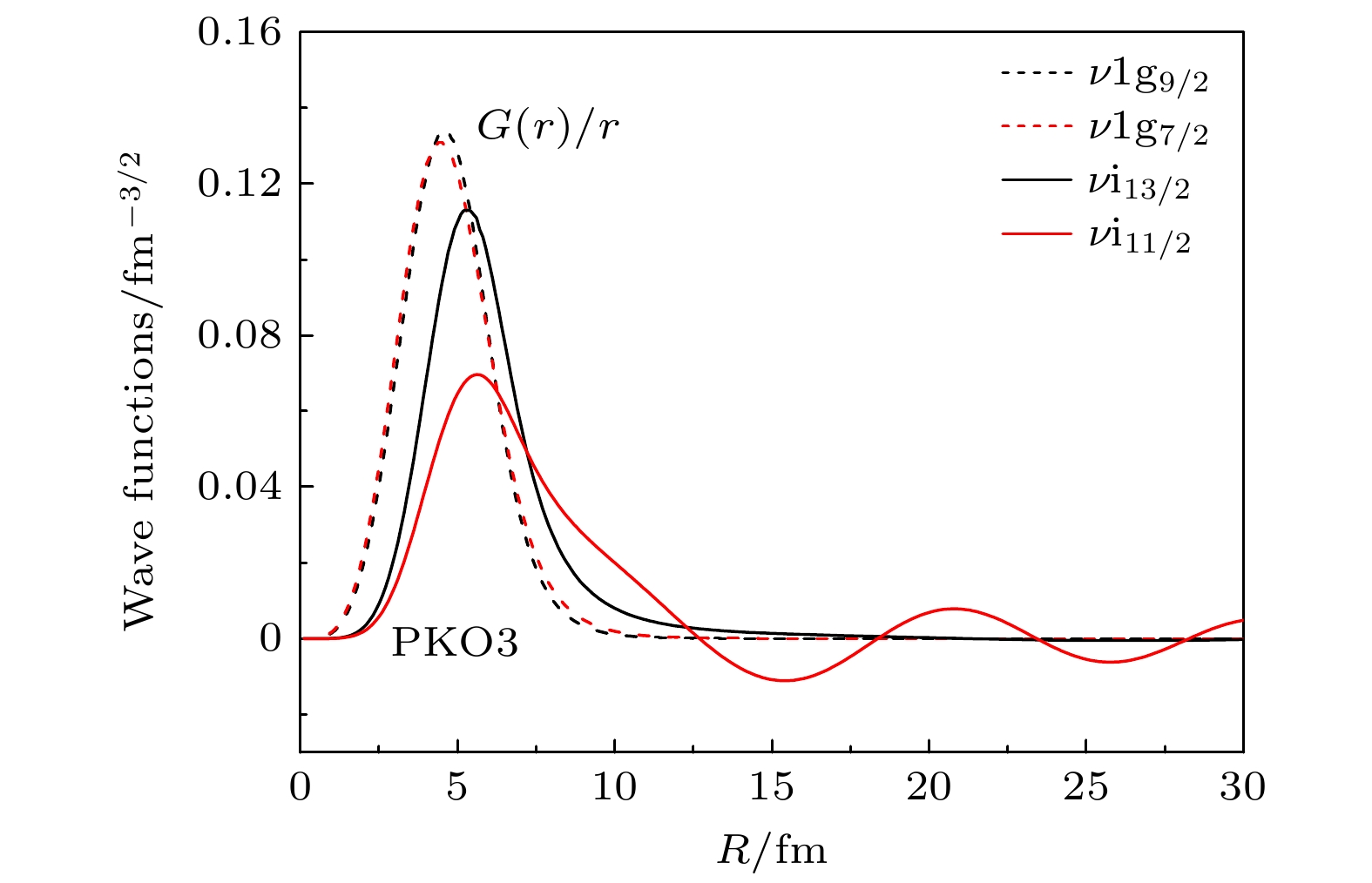-
利用坐标空间的实稳定方法, 在相对论 Hartree-Fock (RHF)理论框架下发展了原子核单粒子共振态结构模型. 具体以120Sn的低激发中子共振态为例, 探讨了交换项在影响共振能量、宽度以及自旋-轨道劈裂等性质中的作用. 相较于一般的相对论平均场(RMF)理论, RHF中交换项的引入改变了核介质中有效核力的动力学平衡机制, 进而影响共振态单粒子势的描述. 对于一般的宽共振态, 这可能导致相对更低的共振能量和更小的共振宽度. 此外, 对120Sn共振态中
$\nu {\mathrm{i}}_{13/2}$ 与$\nu {\mathrm{i}}_{11/2}$ 自旋伙伴态, 还分析了交换项对其自旋-轨道劈裂的相关效应. 与束缚态情形相比, 共振态中自旋伙伴态的波函数可能存在显著区别, 单粒子有效势与能量也相应发生改变. 结果表明, 不仅自旋-轨道相互作用, 单粒子有效势中其他成分也是影响共振态自旋-轨道劈裂的重要因素.-
关键词:
- 单粒子共振态 /
- 实稳定方法 /
- 相对论Hartree-Fock理论 /
- 自旋-轨道劈裂
With the development of radioactive ion beam devices along with associated nuclear experimental detection technologies, the research areas in atomic nuclei have been further expanded, illustrating many new aspects of nuclear excitation as well as the physics of exotic nuclei far from the β-stability line. For weakly bound nuclei, the Fermi surface may lie near the continuum, which facilitates the easy scattering of valence nucleons into the continuum to occupy the resonance state. These continuum effects are of crucial importance in explaining the unusual structure of unstable nuclei. In this work, with the real stabilization method in coordinate space, nuclear structure model for single-particle resonances is developed within the framework of the relativistic Hartree-Fock (RHF) theory. In order to extract potential single-particle resonance structures, we study the evolution of single-particle states with box size in the continuum. To avoid the instability of nuclear binding energy, the pairing correlations are not taken into account in the calculation. As an important motivation, the roles of Fock terms in determining the energy, widths and spin-orbit splitting are discussed for low-lying neutron resonance states of$^{120}$ Sn. By comparing with the relativistic mean field (RMF) model, it is found that the inclusion of exchange terms in the RHF model changes the in-medium balance of nuclear interactions and the equilibrium of nuclear dynamics, which in turn affects the description of the single-particle effective potential. For several neutron resonance states in$^{120}$ Sn with finite resonant width, RHF model predicts lower resonant energy and smaller widths than RMF. For the single-particle states around the continuum threshold, the featured signals of resonance can depend sensitively on the effective interactions. In addition, for the spin-partner states$\nu {\mathrm{i}}_{13/2}$ and$\nu {\mathrm{i}}_{11/2}$ in resonance states, the effect of Fock terms on their spin-orbit splitting is analyzed. In comparison with the bound states, the wave functions of resonant spin-partner states can differ remarkably from each other, changing the effective potential and single-particle energies correspondingly. Thus, additional components in the single-particle effective potential may also contribute to the spin-orbit splitting of resonance states, aside from the spin-orbit interaction. In order to elucidate the mechanism of Fock term in single-particle resonance physics, in the subsequent study more numerical techniques that have been recently developed will be incorporated into the RHF methodology.-
Keywords:
- single-particle resonance states /
- real stabilization method /
- relativistic Hartree-Fock theory /
- spin-orbit splitting
[1] Meng J, Ring P 1998 Phys. Rev. Lett. 80 460
 Google Scholar
Google Scholar
[2] Dobaczewski J, Nazarewicz W, Werner T R, Berger J F, Chinn C R, Dechargé J 1996 Phys. Rev. C 53 2809
 Google Scholar
Google Scholar
[3] Meng J, Ring P 1996 Phys. Rev. Lett. 77 3963
 Google Scholar
Google Scholar
[4] Pöschl W, Vretenar D, Lalazissis G A, Ring P 1997 Phys. Rev. Lett. 79 3841
 Google Scholar
Google Scholar
[5] Meng J, Toki H, Zhou S G, Zhang S Q, Long W H, Geng L S 2006 Prog. Part. Nucl. Phys. 57 470
 Google Scholar
Google Scholar
[6] Liu W, Lou J L, Ye Y L, Pang D Y 2020 Nucl. Sci. Tech. 31 20
 Google Scholar
Google Scholar
[7] Li W J, Ma Y G, Zhang G Q, et al 2019 Nucl. Sci. Tech. 30 180
 Google Scholar
Google Scholar
[8] Khumalo T C, Pellegri L, Wiedeking M, et al. 2023 J. Phys.: Conf. Ser. 2586 012065
 Google Scholar
Google Scholar
[9] Curutchet P, Vertse T, Liotta R J 1989 Phys. Rev. C 39 1020
 Google Scholar
Google Scholar
[10] Cao L G, Ma Z Y 2002 Phys. Rev. C 66 024311
 Google Scholar
Google Scholar
[11] 苟秉聪 1993 42 223
 Google Scholar
Google Scholar
Gou B C 1993 Acta Phys. Sin. 42 223
 Google Scholar
Google Scholar
[12] 孙言, 胡峰, 桑萃萃, 梅茂飞, 刘冬冬, 苟秉聪 2019 68 163101
 Google Scholar
Google Scholar
Sun Y, Hu F, Sang C C, Mei M F, Liu D D, Gou B C 2019 Acta Phys. Sin. 68 163101
 Google Scholar
Google Scholar
[13] Wigner E P, Eisenbud L 1947 Phys. Rev. 72 29
 Google Scholar
Google Scholar
[14] Hale G M, Brown R E, Jarmie N 1987 Phys. Rev. Lett. 59 763
 Google Scholar
Google Scholar
[15] Humblet J, Filippone B W, Koonin S E 1991 Phys. Rev. C 44 2530
 Google Scholar
Google Scholar
[16] Taylor J R 1972 Scattering Theory: The Quantum Theory on Nonrelativistic Collisions (New York: John Wiley & Son) p240
[17] Kukulin V I, Krasnopl’sky V M, Horácek J 1989 Theory of Resonances: Principles and Applications (Dordrecht: Kluwer Academic) p219
[18] Yang S C, Meng J, Zhou S G 2001 Chin. Phys. Lett. 18 196
 Google Scholar
Google Scholar
[19] Tanaka N, Suzuki Y, Varga K, Lovas R G 1999 Phys. Rev. C 59 1391
 Google Scholar
Google Scholar
[20] Cattapan G, Maglione E 2000 Phys. Rev. C 61 067301
 Google Scholar
Google Scholar
[21] Gyarmati B, Kruppa A T 1986 Phys. Rev. C 34 95
 Google Scholar
Google Scholar
[22] Kruppa A T, Heenen P H, Flocard H, Liotta R J 1997 Chin. Phys. Lett. 79 2217
 Google Scholar
Google Scholar
[23] Arai K 2006 Phys. Rev. C 74 064311
 Google Scholar
Google Scholar
[24] Guo J Y, Yu M, Wang J, Yao B M, Jiao P 2010 Comput. Phys. Commun. 181 550
 Google Scholar
Google Scholar
[25] Maier C H, Cederbaum L S, Domcke W 1980 J. Phys. B 13 L119
 Google Scholar
Google Scholar
[26] Taylor H S, Hazi A U 1970 Phys. Rev. A 1 1109
 Google Scholar
Google Scholar
[27] Mandelshtam V A, Ravuri T R, Taylor H S 1993 Phys. Rev. Lett. 70 1932
 Google Scholar
Google Scholar
[28] Mandelshtam V A, Taylor H S, Ryaboy V, Moiseyev N 1994 Phys. Rev. A 50 2764
 Google Scholar
Google Scholar
[29] Serot B D, Walecka J D 1986 Adv. Nucl. Phys. 16 1
[30] Reinhard P G 1989 Rep. Prog. Phys. 52 439
 Google Scholar
Google Scholar
[31] Ring P 1996 Prog. Part. Nucl. Phys. 37 193
 Google Scholar
Google Scholar
[32] Vretenar D, Afanasjev A, Lalazissis G A, Ring P 2005 Phys. Rep. 409 101
 Google Scholar
Google Scholar
[33] Zhang S S, Meng J, Zhou S G, Hillhouse G C 2004 Phys. Rev. C 70 034308
 Google Scholar
Google Scholar
[34] Guo J Y, Fang X Z, Jiao P, Wang J, Yao B M 2010 Phys. Rev. C 82 034318
 Google Scholar
Google Scholar
[35] 刘野, 陈寿万, 郭建友 2012 61 112101
 Google Scholar
Google Scholar
Liu Y, Chen S W, Guo J Y 2012 Acta Phys. Sin. 61 112101
 Google Scholar
Google Scholar
[36] Zhang L, Zhou S G, Meng J, Zhao E G 2008 Phys. Rev. C 77 014312
 Google Scholar
Google Scholar
[37] 张力, 周善贵, 孟杰, 赵恩广 2007 56 3839
 Google Scholar
Google Scholar
Zhang L, Zhou S G, Meng J, Zhao E G 2007 Acta Phys. Sin. 56 3839
 Google Scholar
Google Scholar
[38] Lu B N, Zhao E G, Zhou S G 2012 Phys. Rev. Lett. 109 072501
 Google Scholar
Google Scholar
[39] Lu B N, Zhao E G, Zhou S G 2013 Phys. Rev. C 88 024323
 Google Scholar
Google Scholar
[40] Li Z P, Meng J, Zhang Y, Zhou S G, Savushkin L N 2010 Phys. Rev. C 81 034311
 Google Scholar
Google Scholar
[41] Sun T T, Zhang S Q, Zhang Y, Hu J N, Meng J 2014 Phys. Rev. C 90 054321
 Google Scholar
Google Scholar
[42] Sun T T, Qian L, Chen C, Ring P, Li Z P 2020 Phys. Rev. C 101 014321
 Google Scholar
Google Scholar
[43] Chen C, Li Z P, Li Y X, Sun T T 2020 Chin. Phys. C 44 084105
 Google Scholar
Google Scholar
[44] Sun T T, Li Z P, Ring P 2023 Phys. Lett. B 847 138320
 Google Scholar
Google Scholar
[45] Li N, Shi M, Guo J Y, Niu Z M, Liang H Z 2016 Phys. Rev. Lett. 117 062502
 Google Scholar
Google Scholar
[46] Zhang Y, Qu X Y 2020 Phys. Rev. C 102 054312
 Google Scholar
Google Scholar
[47] Long W H, Giai N V, Meng J 2006 Phys. Lett. B 640 150
 Google Scholar
Google Scholar
[48] Geng J, Long W H 2022 Phys. Rev. C 105 034329
 Google Scholar
Google Scholar
[49] Long W H, Geng J, Liu J, Wang Z H 2022 Commun. Theor. Phys. 74 097301
 Google Scholar
Google Scholar
[50] Long W H, Ring P, Giai N V, Meng J 2010 Phys. Rev. C 81 024308
 Google Scholar
Google Scholar
[51] Jiang L J, Yang S, Sun B Y, Long W H, Gu H Q 2015 Phys. Rev. C 91 034326
 Google Scholar
Google Scholar
[52] Zong Y Y, Sun B Y 2018 Chin. Phys. C 42 024101
 Google Scholar
Google Scholar
[53] Wang Z H, Naito T, Liang H Z, Long W H 2021 Chin. Phys. C 45 064103
 Google Scholar
Google Scholar
[54] Long W H, Sagawa H, Meng J, Giai N V 2008 Europhys. Lett. 82 12001
 Google Scholar
Google Scholar
[55] Wang L J, Dong J M, Long W H 2013 Phys. Rev. C 87 047301
 Google Scholar
Google Scholar
[56] Liang H Z, Zhao P W, Meng J 2012 Phys. Rev. C 85 064302
 Google Scholar
Google Scholar
[57] Niu Z M, Niu Y F, Liang H Z, Long W H, Nikšić T, Vretenar D, Meng J 2013 Phys. Lett. B 723 172
 Google Scholar
Google Scholar
[58] Niu Z M, Niu Y F, Liang H Z, Long W H, Meng J 2017 Phys. Rev. C 95 044301
 Google Scholar
Google Scholar
[59] Lu X L, Sun B Y, Long W H 2013 Phys. Rev. C 87 034311
 Google Scholar
Google Scholar
[60] Li J J, Long W H, Margueron J, Giai N V 2014 Phys. Lett. B 732 169
 Google Scholar
Google Scholar
[61] Li J J, Long W H, Song J L, Zhao Q 2016 Phys. Rev. C 93 054312
 Google Scholar
Google Scholar
[62] Long W H, Sun B Y, Hagino K, Sagawa H 2012 Phys. Rev. C 85 025806
 Google Scholar
Google Scholar
[63] Sun B Y, Long W H, Meng J, Lombardo U 2008 Phys. Rev. C 78 065805
 Google Scholar
Google Scholar
[64] Zhao Q, Sun B Y, Long W H 2015 J. Phys. G: Nucl. Part. Phys. 42 095101
 Google Scholar
Google Scholar
[65] Liu Z W, Qian Z, Xing R Y, Niu J R, Sun B Y 2018 Phys. Rev. C 97 025801
 Google Scholar
Google Scholar
[66] 孙保元 2016 中国科学: 物理学 力学 天文学 46 012018
 Google Scholar
Google Scholar
Sun B Y 2016 SCIENTIA SINICA Physica, Mechanica& Astronomica 46 012018
 Google Scholar
Google Scholar
[67] Li A, Hu J N, Shang X L, Zuo W 2016 Phys. Rev. C 93 015803
 Google Scholar
Google Scholar
[68] Sun B Y, Meng J 2009 Chin. Phys. C 33 73
 Google Scholar
Google Scholar
[69] Long W H, Sagawa H, Meng J, Giai N V 2006 Phys. Lett. B 639 242
 Google Scholar
Google Scholar
[70] Liang H Z, Meng J, Zhou S G 2015 Phys. Rep. 570 1
 Google Scholar
Google Scholar
[71] Geng J, Li J J, Long W H, Niu Y F, Chang S Y 2019 Phys. Rev. C 100 051301(R
 Google Scholar
Google Scholar
[72] Ding S Y, Qian Z, Sun B Y, Long W H 2022 Phys. Rev. C 106 054311
 Google Scholar
Google Scholar
[73] Liu J, Niu Y F, Long W H 2020 Phys. Lett. B 806 135524
 Google Scholar
Google Scholar
[74] Yang S, Sun X D, Geng J, Sun B Y, Long W H 2021 Phys. Rev. C 103 014304
 Google Scholar
Google Scholar
[75] Yang S, Zhang B N, Sun B Y 2019 Phys. Rev. C 100 054314
 Google Scholar
Google Scholar
[76] Bouyssy A, Mathiot J F, Giai N V, Marcos S 1987 Phys. Rev. C 36 380
 Google Scholar
Google Scholar
[77] Long W H, Sagawa H, Giai N V, Meng J 2007 Phys. Rev. C 76 034314
 Google Scholar
Google Scholar
[78] Wei B, Zhao Q, Wang Z H, Geng J, Sun B Y, Niu Y F, Long W H 2020 Chin. Phys. C 44 074107
 Google Scholar
Google Scholar
[79] Long W H, Meng J, Giai N V, Zhou S G 2004 Phys. Rev. C 69 034319
 Google Scholar
Google Scholar
[80] Lalazissis G A, Niksic T, Vretenar D, Ring P 2005 Phys. Rev. C 71 024312
 Google Scholar
Google Scholar
[81] Lalazissis G A, Ring P 1997 Phys. Rev. C 55 540
 Google Scholar
Google Scholar
-
图 1 $ ^{120}$Sn中子共振态的能量随坐标空间截断$ R_\mathrm{max} $的变化. 对$ \nu {\mathrm{i}}_{13/2}, \nu {\mathrm{i}}_{11/2} $和$ \nu {\mathrm{j}}_{15/2} $态, 主量子数n从左到右由$ n=1 $开始依次增加. 图中实线表示RHF有效相互作用 PKO3, 虚线表示RMF有效相互作用PKDD
Fig. 1. Dependence of single-particle energies on the coordinate space cutoff $ R_\mathrm{max} $ for neutron resonance states of $ ^{120}$Sn. For $ \nu {\mathrm{i}}_{13/2},\; \nu {\mathrm{i}}_{11/2} $ and $ \nu {\mathrm{j}}_{15/2} $, the principal quantum numbers start from $ n=1 $ and increase from left to right. The solid lines in the figure is represented as the RHF effective interaction PKO3 and RMF’s PKDD with dashed lines are selected for comparison.
图 3 不同CDF有效相互作用下, $ ^{120} $Sn中子$ \nu {\mathrm{f}}_{5/2}, \nu {\mathrm{i}}_{13/2}, $$ \nu {\mathrm{i}}_{11/2} $和$ \nu {\mathrm{j}}_{15/2} $共振态的共振能量和宽度. 图中黑色、蓝色和绿色标记分别表示RHF, DDRMF和NLRMF有效相互作用的结果
Fig. 3. Single-particle energies and widths of neutron $ \nu {\mathrm{f}}_{5/2}, \nu {\mathrm{i}}_{13/2}, \nu {\mathrm{i}}_{11/2} $ and $ \nu {\mathrm{j}}_{15/2} $ resonances in $ ^{120}\mathrm{Sn} $ with different CDF effective interactions. The black, blue and olive marks in the figure indicate the results with the effective interactions of RHF, DDRMF and NLRMF, respectively
图 4 (a)不同CDF有效相互作用下$ ^{120} $Sn中子$ \nu {\mathrm{j}}_{15/2} $共振态的径向大分量波函数; (b)对中子$ \nu {\mathrm{j}}_{15/2} $共振态, PKO3与PKDD有效相互作用下类薛定谔方程中单粒子有效势和单粒子能级, 其中实线是总的势场, 虚线为直接项贡献, 阴影区域为交换项产生的影响
Fig. 4. (a) Radial wave functions of large component of $ ^{120} $Sn neutron $ \nu {\mathrm{j}}_{15/2} $ resonance state with different CDF effective interactions; (b) for neutron $ \nu {\mathrm{j}}_{15/2} $ resonance state, effective potentials in Schrödinger-like equation and corresponding single-particle energies with PKO3 and PKDD effective interactions. Solid lines are the total potentials, dotted line is the contribution from the direct terms and shaded area comes from the exchange terms of RHF model.
图 5 120Sn核中共振态$ (\nu {\mathrm{i}}_{13/2}, \nu {\mathrm{i}}_{11/2}) $和束缚态$ (\nu 1 {\mathrm{g}}_{9/2}, $$ \nu 1 {\mathrm{g}}_{7/2}) $自旋伙伴态对应的径向大分量波函数, 选取RHF有效相互作用PKO3计算得到
Fig. 5. Radial wave functions of large component of resonance states $ (\nu {\mathrm{i}}_{13/2}, \nu {\mathrm{i}}_{11/2}) $ and bound states $ (\nu 1 {\mathrm{g}}_{9/2}, $$ \nu 1 {\mathrm{g}}_{7/2}) $, given by the RHF effective interaction PKO3.
表 1 根据$^{120}$Sn 中子$\nu {\mathrm{j}}_{15/2}$共振态在不同主量子数n下的$E {\text{-}} R_\mathrm{max}$曲线得到对应的拐点大小$\bar{R}_\mathrm{max}$, 共振能量$E_{\gamma}$以及宽度 Γ. 以RHF有效相互作用PKO3结果为例
Table 1. Resonant energies $E_{\gamma}$, widths Γ and inflection points $\bar{R}_\mathrm{max}$ derived from $E {\text{-}} R_\mathrm{max}$ curves with different principal quantum numbers n for the neutron resonance state $\nu {\mathrm{j}}_{15/2}$ of $^{120}$Sn, illustrated by the RHF effective interaction PKO3.
n $\bar{R}_\mathrm{max}$/fm $E_{\gamma}$/MeV Γ/MeV 1 12.000 12.457 0.518 2 17.731 12.377 0.653 3 22.396 12.368 0.703 4 26.825 12.365 0.738 5 31.145 12.360 0.755 6 35.393 12.358 0.767 表 2 采取不同的CDF有效相互作用给出的120Sn中子共振态的能量和宽度, 表中“\”表示无法提取相关信息. 所有单位均为MeV
Table 2. Single-particle energies and widths of neutron resonances in 120Sn with different CDF effective interactions, “\” in table means that the relevant information could not be calculated. All units are in MeV
$\nu 3 {\mathrm{p}}_{1/2}$ $\nu 1 {\mathrm{h}}_{9/2}$ $\nu {\mathrm{f}}_{5/2}$ $\nu {\mathrm{i}}_{13/2}$ $\nu {\mathrm{i}}_{11/2}$ $\nu {\mathrm{j}}_{15/2}$ $E_{\gamma}$ Γ $E_{\gamma}$ Γ $E_{\gamma}$ Γ $E_{\gamma}$ Γ $E_{\gamma}$ Γ $E_{\gamma}$ Γ PKO1 –0.071 \ 0.262 $\sim$0.000 0.675 0.028 2.802 0.001 9.763 1.152 11.963 0.705 PKO2 –0.096 \ 0.491 $\sim$0.000 1.150 0.127 2.516 0.001 10.171 1.161 11.882 0.586 PKO3 0.028 0.013 0.312 $\sim$0.000 0.834 0.049 3.084 0.002 9.963 1.206 12.358 0.767 DD-LZ1 –0.326 \ 1.437 $6\times 10^{-4}$ 0.268 0.001 4.221 0.016 10.370 1.895 13.277 1.387 PKDD \ \ 1.054 $1\times 10^{-4}$ 1.173 0.153 3.874 0.009 10.737 1.953 13.313 1.279 DD-ME2 –0.057 \ 0.949 $6\times 10^{-5}$ 0.787 0.047 4.038 0.012 10.541 1.874 13.329 1.366 NL3 –0.015 \ \ \ 0.673 0.029 3.263 0.004 9.559 1.205 12.561 0.973 PK1 0.046 0.034 0.250 $\sim$0.000 0.870 0.063 3.468 0.005 9.808 1.274 12.875 1.036 PK1(RMF-GF) 0.050 0.033 0.251 $8\times 10^{-8}$ 0.871 0.065 3.469 0.005 9.854 1.283 12.893 1.065 表 3 120Sn核中$\nu {\rm i}$共振态和$\nu 1 {\rm g}$束缚态的自旋-轨道劈裂$\Delta \varepsilon$, 以及利用类薛定谔方程(9)得到各部分的贡献. 所有单位均为 MeV
Table 3. Spin-orbit splitting of resonance states $\nu {\rm i}$ and bound spin partners $\nu 1 {\rm g}$ in 120Sn, as well as their contributions from various components according to the Schrodinger-like Eq. (9). All units are in MeV
PKO3 PKDD $l=4$ $l=6$ $l=4$ $l=6$ $G''$ –0.856 –1.093 –0.994 –0.434 $\varSigma_+$ 0.297 23.228 0.319 22.183 $V_{{\mathrm{CB}}}$ 0.473 –16.907 0.452 –20.589 $V^{\mathrm{D}}$ 4.362 4.086 7.069 5.703 $V^{\mathrm{E}}$ 1.800 –2.436 0.000 0.000 $\Delta \varepsilon$ 6.074 6.878 6.846 6.863 -
[1] Meng J, Ring P 1998 Phys. Rev. Lett. 80 460
 Google Scholar
Google Scholar
[2] Dobaczewski J, Nazarewicz W, Werner T R, Berger J F, Chinn C R, Dechargé J 1996 Phys. Rev. C 53 2809
 Google Scholar
Google Scholar
[3] Meng J, Ring P 1996 Phys. Rev. Lett. 77 3963
 Google Scholar
Google Scholar
[4] Pöschl W, Vretenar D, Lalazissis G A, Ring P 1997 Phys. Rev. Lett. 79 3841
 Google Scholar
Google Scholar
[5] Meng J, Toki H, Zhou S G, Zhang S Q, Long W H, Geng L S 2006 Prog. Part. Nucl. Phys. 57 470
 Google Scholar
Google Scholar
[6] Liu W, Lou J L, Ye Y L, Pang D Y 2020 Nucl. Sci. Tech. 31 20
 Google Scholar
Google Scholar
[7] Li W J, Ma Y G, Zhang G Q, et al 2019 Nucl. Sci. Tech. 30 180
 Google Scholar
Google Scholar
[8] Khumalo T C, Pellegri L, Wiedeking M, et al. 2023 J. Phys.: Conf. Ser. 2586 012065
 Google Scholar
Google Scholar
[9] Curutchet P, Vertse T, Liotta R J 1989 Phys. Rev. C 39 1020
 Google Scholar
Google Scholar
[10] Cao L G, Ma Z Y 2002 Phys. Rev. C 66 024311
 Google Scholar
Google Scholar
[11] 苟秉聪 1993 42 223
 Google Scholar
Google Scholar
Gou B C 1993 Acta Phys. Sin. 42 223
 Google Scholar
Google Scholar
[12] 孙言, 胡峰, 桑萃萃, 梅茂飞, 刘冬冬, 苟秉聪 2019 68 163101
 Google Scholar
Google Scholar
Sun Y, Hu F, Sang C C, Mei M F, Liu D D, Gou B C 2019 Acta Phys. Sin. 68 163101
 Google Scholar
Google Scholar
[13] Wigner E P, Eisenbud L 1947 Phys. Rev. 72 29
 Google Scholar
Google Scholar
[14] Hale G M, Brown R E, Jarmie N 1987 Phys. Rev. Lett. 59 763
 Google Scholar
Google Scholar
[15] Humblet J, Filippone B W, Koonin S E 1991 Phys. Rev. C 44 2530
 Google Scholar
Google Scholar
[16] Taylor J R 1972 Scattering Theory: The Quantum Theory on Nonrelativistic Collisions (New York: John Wiley & Son) p240
[17] Kukulin V I, Krasnopl’sky V M, Horácek J 1989 Theory of Resonances: Principles and Applications (Dordrecht: Kluwer Academic) p219
[18] Yang S C, Meng J, Zhou S G 2001 Chin. Phys. Lett. 18 196
 Google Scholar
Google Scholar
[19] Tanaka N, Suzuki Y, Varga K, Lovas R G 1999 Phys. Rev. C 59 1391
 Google Scholar
Google Scholar
[20] Cattapan G, Maglione E 2000 Phys. Rev. C 61 067301
 Google Scholar
Google Scholar
[21] Gyarmati B, Kruppa A T 1986 Phys. Rev. C 34 95
 Google Scholar
Google Scholar
[22] Kruppa A T, Heenen P H, Flocard H, Liotta R J 1997 Chin. Phys. Lett. 79 2217
 Google Scholar
Google Scholar
[23] Arai K 2006 Phys. Rev. C 74 064311
 Google Scholar
Google Scholar
[24] Guo J Y, Yu M, Wang J, Yao B M, Jiao P 2010 Comput. Phys. Commun. 181 550
 Google Scholar
Google Scholar
[25] Maier C H, Cederbaum L S, Domcke W 1980 J. Phys. B 13 L119
 Google Scholar
Google Scholar
[26] Taylor H S, Hazi A U 1970 Phys. Rev. A 1 1109
 Google Scholar
Google Scholar
[27] Mandelshtam V A, Ravuri T R, Taylor H S 1993 Phys. Rev. Lett. 70 1932
 Google Scholar
Google Scholar
[28] Mandelshtam V A, Taylor H S, Ryaboy V, Moiseyev N 1994 Phys. Rev. A 50 2764
 Google Scholar
Google Scholar
[29] Serot B D, Walecka J D 1986 Adv. Nucl. Phys. 16 1
[30] Reinhard P G 1989 Rep. Prog. Phys. 52 439
 Google Scholar
Google Scholar
[31] Ring P 1996 Prog. Part. Nucl. Phys. 37 193
 Google Scholar
Google Scholar
[32] Vretenar D, Afanasjev A, Lalazissis G A, Ring P 2005 Phys. Rep. 409 101
 Google Scholar
Google Scholar
[33] Zhang S S, Meng J, Zhou S G, Hillhouse G C 2004 Phys. Rev. C 70 034308
 Google Scholar
Google Scholar
[34] Guo J Y, Fang X Z, Jiao P, Wang J, Yao B M 2010 Phys. Rev. C 82 034318
 Google Scholar
Google Scholar
[35] 刘野, 陈寿万, 郭建友 2012 61 112101
 Google Scholar
Google Scholar
Liu Y, Chen S W, Guo J Y 2012 Acta Phys. Sin. 61 112101
 Google Scholar
Google Scholar
[36] Zhang L, Zhou S G, Meng J, Zhao E G 2008 Phys. Rev. C 77 014312
 Google Scholar
Google Scholar
[37] 张力, 周善贵, 孟杰, 赵恩广 2007 56 3839
 Google Scholar
Google Scholar
Zhang L, Zhou S G, Meng J, Zhao E G 2007 Acta Phys. Sin. 56 3839
 Google Scholar
Google Scholar
[38] Lu B N, Zhao E G, Zhou S G 2012 Phys. Rev. Lett. 109 072501
 Google Scholar
Google Scholar
[39] Lu B N, Zhao E G, Zhou S G 2013 Phys. Rev. C 88 024323
 Google Scholar
Google Scholar
[40] Li Z P, Meng J, Zhang Y, Zhou S G, Savushkin L N 2010 Phys. Rev. C 81 034311
 Google Scholar
Google Scholar
[41] Sun T T, Zhang S Q, Zhang Y, Hu J N, Meng J 2014 Phys. Rev. C 90 054321
 Google Scholar
Google Scholar
[42] Sun T T, Qian L, Chen C, Ring P, Li Z P 2020 Phys. Rev. C 101 014321
 Google Scholar
Google Scholar
[43] Chen C, Li Z P, Li Y X, Sun T T 2020 Chin. Phys. C 44 084105
 Google Scholar
Google Scholar
[44] Sun T T, Li Z P, Ring P 2023 Phys. Lett. B 847 138320
 Google Scholar
Google Scholar
[45] Li N, Shi M, Guo J Y, Niu Z M, Liang H Z 2016 Phys. Rev. Lett. 117 062502
 Google Scholar
Google Scholar
[46] Zhang Y, Qu X Y 2020 Phys. Rev. C 102 054312
 Google Scholar
Google Scholar
[47] Long W H, Giai N V, Meng J 2006 Phys. Lett. B 640 150
 Google Scholar
Google Scholar
[48] Geng J, Long W H 2022 Phys. Rev. C 105 034329
 Google Scholar
Google Scholar
[49] Long W H, Geng J, Liu J, Wang Z H 2022 Commun. Theor. Phys. 74 097301
 Google Scholar
Google Scholar
[50] Long W H, Ring P, Giai N V, Meng J 2010 Phys. Rev. C 81 024308
 Google Scholar
Google Scholar
[51] Jiang L J, Yang S, Sun B Y, Long W H, Gu H Q 2015 Phys. Rev. C 91 034326
 Google Scholar
Google Scholar
[52] Zong Y Y, Sun B Y 2018 Chin. Phys. C 42 024101
 Google Scholar
Google Scholar
[53] Wang Z H, Naito T, Liang H Z, Long W H 2021 Chin. Phys. C 45 064103
 Google Scholar
Google Scholar
[54] Long W H, Sagawa H, Meng J, Giai N V 2008 Europhys. Lett. 82 12001
 Google Scholar
Google Scholar
[55] Wang L J, Dong J M, Long W H 2013 Phys. Rev. C 87 047301
 Google Scholar
Google Scholar
[56] Liang H Z, Zhao P W, Meng J 2012 Phys. Rev. C 85 064302
 Google Scholar
Google Scholar
[57] Niu Z M, Niu Y F, Liang H Z, Long W H, Nikšić T, Vretenar D, Meng J 2013 Phys. Lett. B 723 172
 Google Scholar
Google Scholar
[58] Niu Z M, Niu Y F, Liang H Z, Long W H, Meng J 2017 Phys. Rev. C 95 044301
 Google Scholar
Google Scholar
[59] Lu X L, Sun B Y, Long W H 2013 Phys. Rev. C 87 034311
 Google Scholar
Google Scholar
[60] Li J J, Long W H, Margueron J, Giai N V 2014 Phys. Lett. B 732 169
 Google Scholar
Google Scholar
[61] Li J J, Long W H, Song J L, Zhao Q 2016 Phys. Rev. C 93 054312
 Google Scholar
Google Scholar
[62] Long W H, Sun B Y, Hagino K, Sagawa H 2012 Phys. Rev. C 85 025806
 Google Scholar
Google Scholar
[63] Sun B Y, Long W H, Meng J, Lombardo U 2008 Phys. Rev. C 78 065805
 Google Scholar
Google Scholar
[64] Zhao Q, Sun B Y, Long W H 2015 J. Phys. G: Nucl. Part. Phys. 42 095101
 Google Scholar
Google Scholar
[65] Liu Z W, Qian Z, Xing R Y, Niu J R, Sun B Y 2018 Phys. Rev. C 97 025801
 Google Scholar
Google Scholar
[66] 孙保元 2016 中国科学: 物理学 力学 天文学 46 012018
 Google Scholar
Google Scholar
Sun B Y 2016 SCIENTIA SINICA Physica, Mechanica& Astronomica 46 012018
 Google Scholar
Google Scholar
[67] Li A, Hu J N, Shang X L, Zuo W 2016 Phys. Rev. C 93 015803
 Google Scholar
Google Scholar
[68] Sun B Y, Meng J 2009 Chin. Phys. C 33 73
 Google Scholar
Google Scholar
[69] Long W H, Sagawa H, Meng J, Giai N V 2006 Phys. Lett. B 639 242
 Google Scholar
Google Scholar
[70] Liang H Z, Meng J, Zhou S G 2015 Phys. Rep. 570 1
 Google Scholar
Google Scholar
[71] Geng J, Li J J, Long W H, Niu Y F, Chang S Y 2019 Phys. Rev. C 100 051301(R
 Google Scholar
Google Scholar
[72] Ding S Y, Qian Z, Sun B Y, Long W H 2022 Phys. Rev. C 106 054311
 Google Scholar
Google Scholar
[73] Liu J, Niu Y F, Long W H 2020 Phys. Lett. B 806 135524
 Google Scholar
Google Scholar
[74] Yang S, Sun X D, Geng J, Sun B Y, Long W H 2021 Phys. Rev. C 103 014304
 Google Scholar
Google Scholar
[75] Yang S, Zhang B N, Sun B Y 2019 Phys. Rev. C 100 054314
 Google Scholar
Google Scholar
[76] Bouyssy A, Mathiot J F, Giai N V, Marcos S 1987 Phys. Rev. C 36 380
 Google Scholar
Google Scholar
[77] Long W H, Sagawa H, Giai N V, Meng J 2007 Phys. Rev. C 76 034314
 Google Scholar
Google Scholar
[78] Wei B, Zhao Q, Wang Z H, Geng J, Sun B Y, Niu Y F, Long W H 2020 Chin. Phys. C 44 074107
 Google Scholar
Google Scholar
[79] Long W H, Meng J, Giai N V, Zhou S G 2004 Phys. Rev. C 69 034319
 Google Scholar
Google Scholar
[80] Lalazissis G A, Niksic T, Vretenar D, Ring P 2005 Phys. Rev. C 71 024312
 Google Scholar
Google Scholar
[81] Lalazissis G A, Ring P 1997 Phys. Rev. C 55 540
 Google Scholar
Google Scholar
计量
- 文章访问数: 3719
- PDF下载量: 87
- 被引次数: 0


















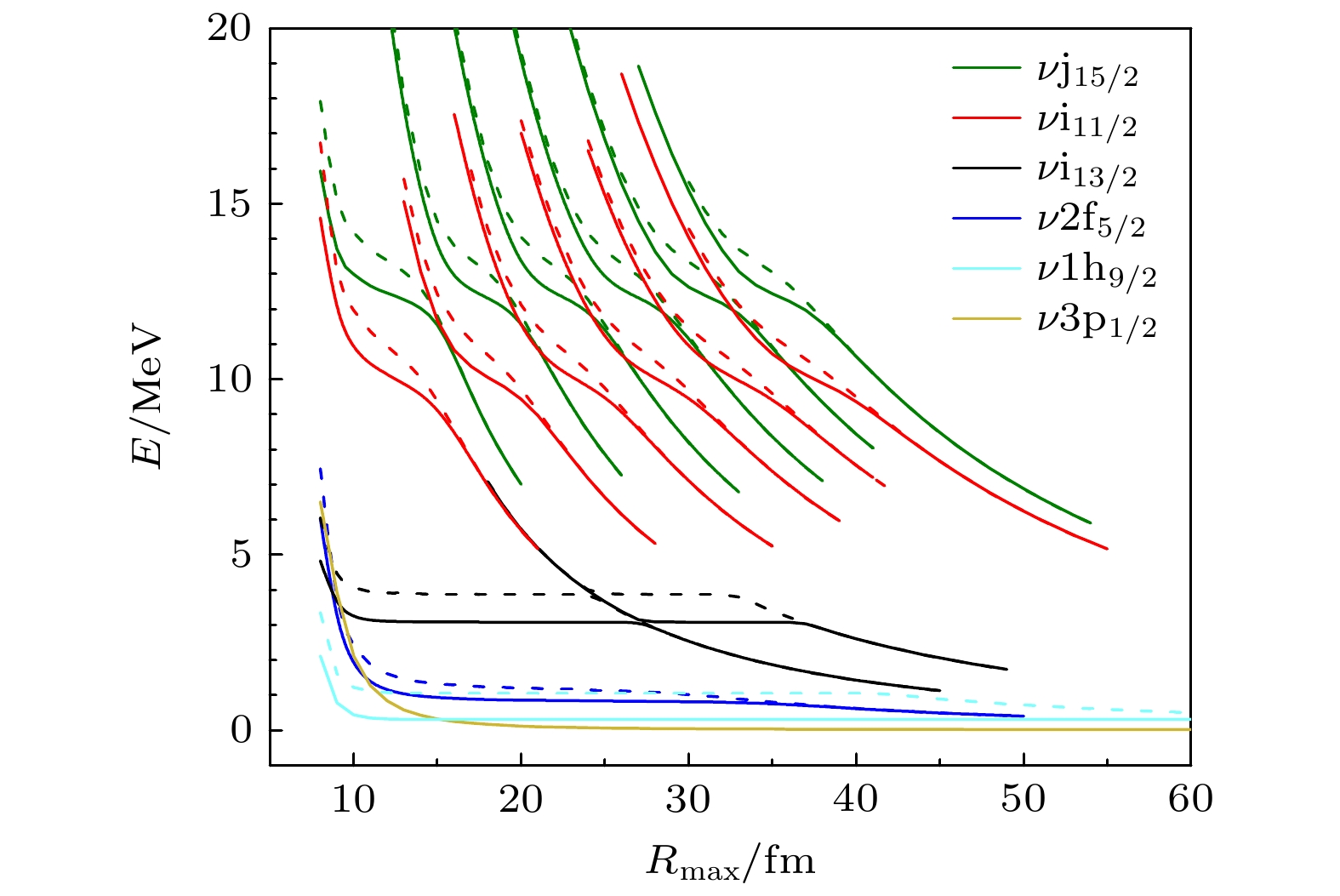
 下载:
下载:
